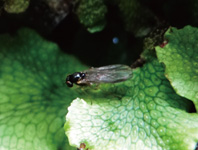Abstract
In many Opiliones (notably the Laniatores) the five most anterior opisthosomal tergites are fused with the carapace forming the so called dorsal scutum (DS) (Latreille 1804; Simon 1879; Hadži 1942) with a highly variable shape arising from multiple factors, such as differential development of musculature (especially of coxa IV), internal organs and influence of appendages (Loman 1903; Winkler 1957). The different degrees of fusion of the tergites were first studied by Hadži (1942), who proposed a terminology for them. This terminology was adopted and enhanced by Kratochvíl (1958) and Martens (1978). A shield formed by the fusion of the carapace with abdominal tergites I to V is called scutum magnum (Hadži 1942). The shield formed by the fusion of carapace with abdominal tergites I to VII is called scutum complexum (Kratochvíl 1958) and occurs in the males of Heteropachylinae Kury, 1994 (Kury 1994) and Paralolidae Kratochvíl, 1958 (Kratochvíl 1958). Finally, the scutum completum (Hadži 1942) is formed by the complete fusion of the carapace and abdominal scutum, formed by tergites I to VIII, and occurs in the Sandokanidae (Martens 1978). In this paper we focus on the different forms of the scutum magnum.
References
Hadži, J. (1942) Raziskovanja o ishiropsalidih (Opiliones) [Untersuchungen über die Ischyropsaliden (Opiliones)]. Razprave Matematicno-Prirodoslovnega Razprave Akademija Znanosti in Umnetnosti, 21, 5–114.
Kratochvíl, J. (1958) Die Höhlenweberknechte Bulgariens (Cyphophthalmi und Laniatores) [Jeskynní sekáči Bulharska (Cyphophthalmi a Laniatores)]. Práce Brněnské základny Československé akademie věd, 30 (9), 371–396.
Kury, A.B. (1994) Early lineages of Gonyleptidae (Arachnida, Opiliones, Laniatores). Tropical Zoology, 7 (2), 343–353.
http://dx.doi.org/10.1080/03946975.1994.10539264Kury, AB (2012) A new genus of Cranaidae from Ecuador (Opiliones: Laniatores). Zootaxa, 3314, 31–44.
Kury, A.B. (2014) Why does the Tricommatinae position bounce so much within Laniatores? A cladistic analysis, with description of a new family of Gonyleptoidea (Opiliones, Laniatores). Zoological Journal of the Linnean Society, 172, 1–48.
http://dx.doi.org/10.1111/zoj.12165Kury, A.B. & Barros, CM. (2014) A new genus and eight new species of Amazonian cosmetines (Opiliones, Laniatores, Cosmetidae). Zoological Studies, 53, 1–46.
http://dx.doi.org/10.1186/s40555-014-0024-4Kury, A.B., Villarreal-M., O. & Costa C.S. (2007) Redescription of the type species of Cynorta Koch, 1839 (Arachnida, Opiliones, Cosmetidae). The Journal of Arachnology, 35 (2), 325–333.
http://dx.doi.org/10.1636/H06-35.1Kury A.B. & Villarreal M.O. (2015) The prickly blade mapped: establishing homologies and a chaetotaxy for macrosetae of penis ventral plate in Gonyleptoidea (Arachnida, Opiliones, Laniatores). Zoological Journal of the Linnean Society, 174 (1), 1–46.
http://dx.doi.org/10.1111/zoj.12225Latreille, P.A. (1804) Huitième genre-Dixième genre In: Sonnini, C.S. (Ed.) Histoire naturelle, générale et particulière des Crustacés et des Insectes. Vol. 7. F. Dufart, Paris, pp. 314–329.
Loman, J.C.C. (1903) Vergleichend anatomische Untersuchungen an chilenischen und anderen Opilioniden. Zoologische Jahrbücher, Jena, Supplement, 6 (1) [“1905”] (Fauna chilensis, dritter Band), 117–200, pls x–xiii.
Martens, J. (1978) Spinnentiere, Arachnida: Weberknechte, Opiliones. Die Tierwelt Deutschlands. Vol. 64. G. Fischer Verlag, Jena, 464 pp.
Pinto-da-Rocha, R. & Hara, M.R. (2011) Redescription of Platygyndes Roewer 1943, a false Gonyleptidae, (Arachnida, Opiliones, Cosmetidae). ZooKeys, 143, 1–12.
http://dx.doi.org/10.3897/zookeys.143.1916Ringuelet, R.A. (1959) Los aracnidos Argentinos del orden Opiliones. Revista del Museo Argentino de Ciencias Naturales "Bernardino Rivadavia." Ciencias Zoologicas 5 (2), 127–439, figs 1–62, plates 1–20.
Rodriguez, A.L., Townsend Jr, V.R., Johnson, M.B. & White, T.B. (2014) Interspecific variation in the microanatomy of cosmetid harvestmen (Arachnida, Opiliones, Laniatores). Journal of Morphology, 275, 1386–1405.
http://dx.doi.org/10.1002/jmor.20312Roewer, C.F. (1923) Die Weberknechte der Erde. Systematische Bearbeitung der bisher bekannten Opiliones. Gustav Fischer, Jena, 1116 pp.
Roewer, C.F. (1943) Über Gonyleptiden. Weitere Webernechte (Arachn., Opil.) XI. Senckenbergiana, Frankfurt, 26 (1–3), 12–68.
Simon, E. (1879) Les Arachnides de France. Tome 7. Contenant les ordres des Chernetes, Scorpiones et Opiliones. Librairie Encyclopédique de Roret, Paris, pp. 1–332, pl. 17–24. [Opiliones pp. 116–332, pl. 21–24].
Townsend, V.R. Jr., Víquez, C., Vanzandt, P.A. & Proud, D.N. (2010) Key to the Species of Cosmetidae (Arachnida, Opiliones) of Central America, with Notes on Penis Morphology and Sexual Dimorphisms. Zootaxa, 2414, 1–26.
Winkler, D. (1957) Die Entwicklung der äusseren Körpergestalt bei den Phalangiidae (Opiliones). Mitteilungen aus dem Museum für Naturkunde in Berlin, 33, 355–389.
http://dx.doi.org/10.1002/mmnz.19570330204

